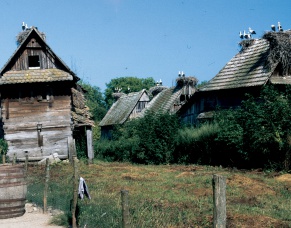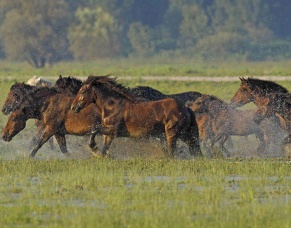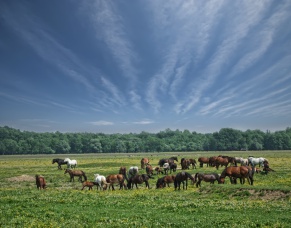Lonjsko Polje Nature Park
A Living Landscape
Lonjsko Polje Nature Park – A Living Landscape and Floodplain Ecosystem of the Central Sava River Basin
Lonjsko Polje Nature Park is one of the biggest floodplains in Europe, a complex of lowland riparian hardwood forests, marshes, water meadows, pools and oxbows. It is affected by traditional farming that is adapted to periodic inundation. The long and continuous tradition of living with the floods has created an extraordinary system that impinges on all aspects of human interaction with the environment, such as the vernacular building, the settlement pattern and the shaping of the landscape, the use of the land as well as the creation of indigenous domestic breeds perfectly adapted to the conditions of the floodplain.
The biggest complex of natural and preserved lowland riparian forests in Europe and even beyond are right here in the area of Lonjsko Polje Nature Park. Water and flooding are the main factors that dictate the development of the species and plant communities of the forest habitats. The lowland riparian woodlands cover almost 70% of the area of Lonjsko Polje Nature Park. The wet grasslands that are frequently inundated are one of the most dynamic of the habitats.They cover about 30% of the area of Lonjsko Polje Nature Park. They have an important ecological and economic role as part of the traditional system of pasturing and in the preservation of the landrace breeds.
The appearance and adaptives features of the white stork in its life together with people are visible in the construction of the nests, which are closely connected with human buildings.Because of the large number of nests on the roofs of the traditional wooden houses, in 1984 Čigoč was proclaimed the “First European Stork Village”. About 15% of the Croatian population of the white-tailed eagle nests in the area of Lonjsko Polje Nature Park.The stability of the 36 nesting pairs is an indicator of the preservation of the integrity of the lowland riparian forests of the central Sava valley, and Lonjsko Polje thus occupies an important position in the population of eagles in the whole Danube basin. A mixed colony of spoonbillsand herons situated in the oxbow of Krapje Djol Ornithological Reserve is the only recorded breeding area where the adult birds use the wet pastures for foraging during the reproduction period.
A particular value of Lonjsko Polje consists of the settlements along the Sava River. Historically speaking,the villages of Lonjsko Polje are traditional units that tell of the way of life and the manner of building dwellings in Posavina during the 19th century. They are at the same time a real reserve of excellently preserved vernicularwooden architecture . Some of the tipycal wooden houses are more than 200 years old. For these values, Krapje is of national importance and it is the only village in Croatia to have the status of “Village of the Architectural Heritage”.



